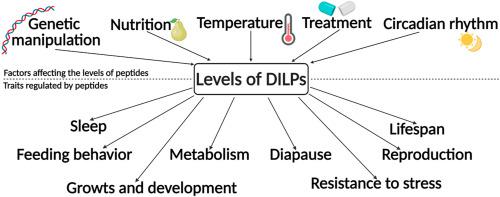Insect Biochemistry and Molecular Biology ( IF 3.2 ) Pub Date : 2021-06-17 , DOI: 10.1016/j.ibmb.2021.103609 Uliana Semaniuk 1 , Olha Strilbytska 1 , Karina Malinovska 1 , Kenneth B Storey 2 , Alexander Vaiserman 3 , Volodymyr Lushchak 4 , Oleh Lushchak 4

|
Insulin-like peptides (ILPs) and components of the insulin signaling pathway are conserved across different animal phyla. Eight ILPs (called DILPs) and two receptors, dInR and Lgr3, have been described in Drosophila. DILPs regulate varied physiological traits including lifespan, reproduction, development, feeding behavior, stress resistance and metabolism. At the same time, different conditions such as nutrition, dietary supplements and environmental factors affect the expression of DILPs. This review focuses primarily on DILP2, DILP3, and DILP5 which are produced by insulin-producing cells in the brain of Drosophila. Although they are produced by the same cells and can potentially compensate for each other, DILP2, DILP3, and DILP5 expression may be differentially regulated at the mRNA level. Thus, we summarized available data on the conditions affecting the expression profiles of these DILPs in adult Drosophila. The accumulated data indicate that transcript levels of DILPs are determined by (a) nutritional conditions such as the protein-to-carbohydrate ratio, (b) carbohydrate type within the diet, (c) malnutrition or complete starvation; (d) environmental factors such as stress or temperature; (e) mutations of single peptides that induce changes in the expression of the other peptides; and (f) dietary supplements of drugs or natural substances. Furthermore, manipulation of specific genes in a cell- and tissue-specific manner affects mRNA levels for DILPs and, thereby, modulates various physiological traits and metabolism in Drosophila.
中文翻译:

调节胰岛素样肽表达模式的因素及其与果蝇生理和代谢特征的关联
胰岛素样肽 (ILP) 和胰岛素信号通路的成分在不同的动物门中是保守的。已在果蝇中描述了八个 ILP(称为 DILP)和两个受体,dInR 和 Lgr3。DILP 调节各种生理特征,包括寿命、繁殖、发育、进食行为、抗压性和新陈代谢。同时,营养、膳食补充剂和环境因素等不同条件会影响DILPs的表达。本综述主要关注果蝇大脑中产生胰岛素的细胞产生的 DILP2、DILP3 和 DILP5. 尽管它们由相同的细胞产生并且可能相互补偿,但 DILP2、DILP3 和 DILP5 的表达可能在 mRNA 水平受到差异调节。因此,我们总结了有关影响这些 DILP 在成年果蝇中表达谱的条件的可用数据. 累积的数据表明,DILP 的转录水平取决于 (a) 营养条件,例如蛋白质与碳水化合物的比例,(b) 饮食中的碳水化合物类型,(c) 营养不良或完全饥饿;(d) 环境因素,例如压力或温度;(e) 诱导其他肽表达变化的单个肽的突变;(f) 药物或天然物质的膳食补充剂。此外,以细胞和组织特异性方式操纵特定基因会影响 DILP 的 mRNA 水平,从而调节果蝇的各种生理特征和代谢。









































 京公网安备 11010802027423号
京公网安备 11010802027423号